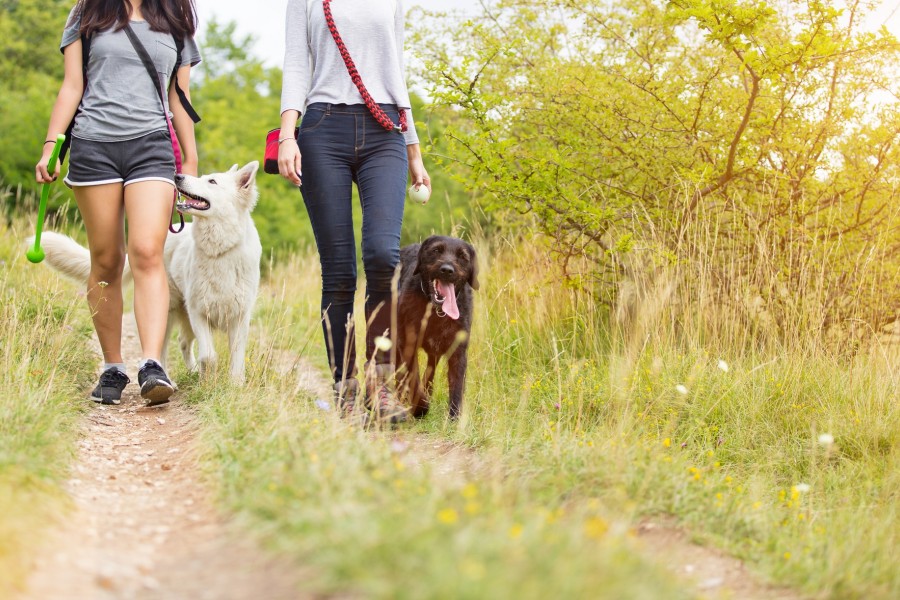How to introduce dogs to each other, especially if they are not confident or aggressive!

I see so many people introducing dogs the totally wrong way, so I thought I’d give this simple yet effective technique to help everyone’s dogs. Please be aware that some dogs are more difficult to introduce to other dogs, so my disclaimer is, don’t do this if you are not confident in your ability to read a dog’s body language. If you have an aggressive dog and you want to try socialising it then consult a good dog trainer.
Done right you can introduce the most aggressive dogs to each other using this technique. Again… don’t attempt to do that without a good dog trainer present if your dog is aggressive. In general, most dogs aren’t aggressive, and this is a good technique for those dogs, if you want to ensure a pleasant meeting.
So, if two dogs are super friendly then you can basically introduce them at the end of a lead like most people do and it’s all fine. However, if you tried using this technique with a nervous, unsure or aggressive dog then you will often have a drama follow. The reason being the lead/leash creates tension and doesn’t allow them to act in a normal way.
The other reason it doesn’t work for many dogs is it doesn’t give enough time for them to do the normal body language process they would do if they were in a natural setting.
An Important but simple rule before I start. Always let your dog play with and meet dogs of approximately the same size. This is because of two reasons.
- It’s very intimidating for a small dog to meet a large dog. Imagine a Chihuahua meeting a Great Dane. It would be like meeting a person that is 40 foot tall and weighs 3.5 tonnes. Now that’s intimidating.
- If for whatever reason the big dog does decide to bite the little dog the damage can be fatal or life changing. And we don’t want that. Even in play, large dogs can hurt smaller dogs, so just don’t risk it.
Now that’s out of the way, here is my super dooper dog meeting method.
Get both dogs on a leash and walk in the same direction about a street width apart. Try not to have them walk directly towards each other at any point in time, even from a distance. With aggressive dogs just by walking toward another dog you can activate their desire to fight so avoid walking directly towards the other dog at any time. When you meet up you want to come from similar directions and merge like you would on a merging lane on the freeway.
Once you merge and are walking about a street width apart you will start seeing the dogs looking at each other. Depending on what type of dog they are they may show aggression, or they may show a bit of fear. At this point it doesn’t matter how they react; you just want to see a change in demeanour, so you know they have seen each other.
From here, just keep walking about the same distance apart. Usually, after a few minutes, they accept each other, and you will see they will look at each other casually. From here it's ok to start walking closer but still stay far enough away so they can’t have contact.
As you keep walking you will start to see they have acknowledged each other and are calm and relaxed about each other. At this point, you can start merging closer until they can touch.
If one of the dogs doesn’t calm down, then don’t attempt to bring them closer. Some dogs may take hours to calm down. Most will calm in under 10 minutes. It's up to you to accurately judge the situation.
If you have a super aggressive dog, try to introduce it to a calm confident dog that has heaps of experience playing with other dogs. Also, younger dogs usually have respect for older dogs and older dogs usually have that calm energy about them that you need to overcome the nerves of an aggressive or timid dog.
Once you introduce the dogs, keep walking together and allowing them to touch if they want. If one of the dogs is aggressive you want to do this walking together many times before you allow them to be together without leashes attached. Also, be aware some dogs just like to fight so if it’s that type of dog you really need to continually watch their body language. Other things you want to look out for is if they find something together like a bone or ball, something like that could give a feisty dog a reason to start fighting. So be aware of these possibilities.
A situation where you don’t really want to try socialising two dogs together is where there is a history of fighting among the two dogs. In this situation, it's best just not to socialise these dogs together again. If they must get along then get a dog trainer in. But usually, it means separation forever if they have fought a few times.
In general, I have found this is the best way to introduce two dogs together especially if one dog is a bit unsure about meeting other dogs. Let me know how you go using this technique and let me know if you have any questions or come across any issues.

What is &?